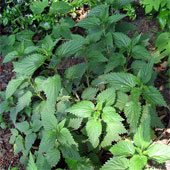The Burning, Itching, And Swelling Of Stinging Nettles: Removing Them From The Skin

Stinging nettle plants, courtesy of Dezidor (CC BY 3.0)
Hikers often brush up against injurious plants, such as poison oak or thorny shrubs. One particularly vexing plant is the “ubiquitous weed, Urtica dioica,” commonly known as stinging nettles. As described in an article entitled “Mechanism of Action of Stinging Nettles” (Wilderness & Environmental Medicine:22,136-139,2011) by Alexander Cummings and Michael Olsen, direct contact exposure to the weed causes immediate stinging and burning sensation on the skin. The authors exposed mouse skin to the plants and looked at this skin using an electron microscope. They found smooth nettle spicules that had pierced the skin surface, a few of which retained their bases, which appeared empty of liquid contents. The authors concluded that the mechanism of action of stinging nettles skin reaction was both biochemical and mechanical, likely caused by impalement of spicules into the skin.
The spicules are present as small “hairs” that are found on the stem and undersides of the leaves of the plant. Even light touch against the plant can cause a reaction, which is often characterized as Read more »
This post, The Burning, Itching, And Swelling Of Stinging Nettles: Removing Them From The Skin, was originally published on Healthine.com by Paul Auerbach, M.D..











